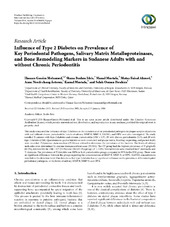Influence of type 2 diabetes on prevalence of key periodontal pathogens, salivary matrix metalloproteinases and bone remodeling markers in adults with and without chronic periodontitis
Mohamed, Hasaan Gassim; Idris, Shaza Bushra Mohamed; Mustafa Sharafeldin, Manal Ibrahim; Ahmed, Mutaz Faisal; Åstrøm, Anne Nordrehaug; Mustafa, Kamal Babikeir Eln; Ibrahim, Salah Osman
Peer reviewed, Journal article
Published version

Åpne
Permanent lenke
https://hdl.handle.net/1956/15317Utgivelsesdato
2016Metadata
Vis full innførselSamlinger
Originalversjon
https://doi.org/10.1155/2016/6296854Sammendrag
This study compared the influence of type 2 diabetes on the occurrence of six periodontal pathogens in plaque samples of patients with and without chronic periodontitis. Levels of salivary MMP-8, MMP-9, RANKL, and OPG were also investigated. The study enrolled 31 patients with type 2 diabetes and chronic periodontitis (DM + CP), 29 with chronic periodontitis (CP), and 20 with type 2 diabetes (DM). Questionnaire-guided interviews were conducted and plaque index, bleeding on probing, and pocket depth were recorded. Polymerase chain reaction (PCR) was utilized to determine the prevalence of the bacteria. The levels of salivary molecules were determined by enzyme immunosorbent assay (ELISA). The CP group had the highest prevalence of P. gingivalis (81.5%), followed by the DM + CP (59.3%) and DM (55.0%) groups (). Similar trends were observed for P. intermedia and T. denticola. The prevalence of T. forsythia was 100% in both periodontitis groups compared to 90% in the DM group. There were no significant differences between the groups regarding the concentrations of MMP-8, MMP-9, or OPG. RANKL concentrations were below the detection limit. Our data show that type 2 diabetes has no significant influence on the prevalence of the investigated periodontal pathogens, or the levels of salivary MMP-8, MMP-9, and OPG.
